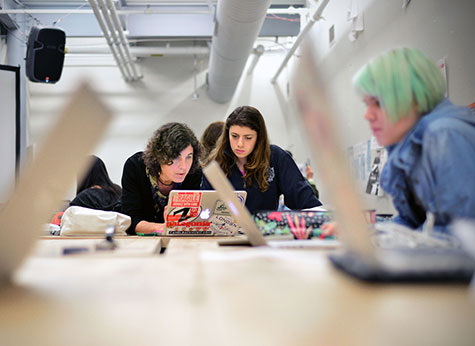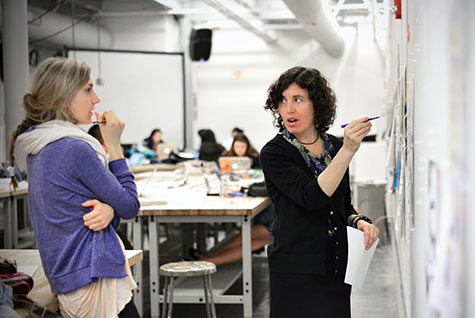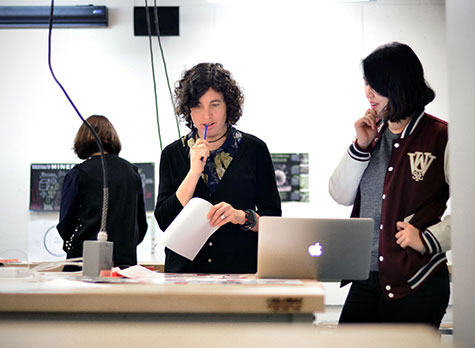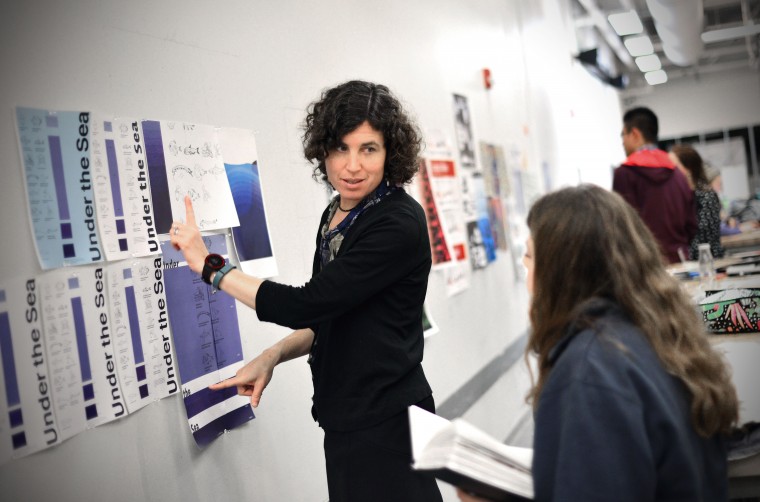Visual design can have a profound impact on learning. Measurably so.
In 2011, Heather Corcoran worked with colleagues in public heath and cancer prevention at Washington University in St. Louis to create a new interface for presenting cancer rate data. Funded by a $225,000 federal grant — the largest in the history of the Sam Fox School of Design & Visual Arts — the results were eye-popping. Retention improved five-fold.
Last summer, Corcoran was appointed director of the Sam Fox School’s College & Graduate School of Art. In the fall, she was installed as the Jane Reuter Hitzeman and Herbert F. Hitzeman, Jr. Professor of Art and also opened a one-person show of her own work, “Reading Time,” at Northeastern University’s Gallery 360 in Boston.
These days, it’s hard to catch her. But Corcoran slowed down long enough to discuss data visualization, the importance of design to health care and art directing the Portland Trail Blazers:

You earned an MFA in graphic design from Yale in 1998 but as an undergraduate studied English literature at Wesleyan University in Middleton, Conn. Why English?
I was a military kid. I grew up everywhere — mostly on the coasts, because my dad was in the Navy. Key West, Newport, San Diego, Alexandria, Va., Bremerton, Wash. … By the time I went to college, I had moved 18 times.
So you were a reader.
I was a reader. And we were a no-TV family, which at the time I thought was most unfortunate (laughs). Also, my dad was a writer and the house was filled with novels. Dickens, Trollope, George Eliot, Hemingway, Charlotte Bronte. … I read a lot of 19th-century literature and a fair amount of 20th.
In spite of that, when I got to college, I absolutely loved microeconomics and almost became an econ major. But eventually English kicked back in.
How did you come to design?
Wesleyan didn’t really have a design program, but it had a print shop with a strong and interesting letterpress tradition. I had done calligraphy as a kid. I took a typography class almost on a whim. It seemed like a way to connect literature with a visual approach to letter forms.
It was magic. I knew immediately that I had found my thing. I took every class Wesleyan offered, and then did independent studies until graduation.
That was my foundation, and, to this day, I rely on my visual training and letterpress/literary leanings. In fact, I recently opened a show of my own work entitled “Reading Time: Visual Timelines, Texts and Canons,” which links literary and personal work to some of my more current work in data visualization.

You spent several years working before going back to graduate school. What was your first job out of college?
I was the art director for the Portland Trail Blazers, the NBA basketball team.
Seriously?
Seriously. It was the first time they had hired an art director, and I could not have been less qualified for the job. But I worked very hard and got a lot of experience fast. I art-directed team photos, designed billboards, a basketball court, tickets, advertisements … lots of crazy stuff.
What’s involved in designing a basketball court?
There are all of the technical specifications for the court, of course, but I needed to think about colors, proportions, the logo, the sight lines and how everything would play out on television. And there’s the Blazers’ history and how the redesign should relate to courts from different moments in time. And there’s also the issue of getting buy-in from the coach, the marketing people, the TV people … everyone cares about the court.
Working for a franchise like the Blazers, you have to differentiate between aesthetic decision-making and how projects actually move through the organization. The person who sells the tickets may not care much about the visual coherence of the tickets, but cares a lot about how well they will excite fans.

Today your work centers on questions of data visualization and social impact. At the Sam Fox School, you’ve led workshops on interaction design. What is interaction design?
Graphic designers think it grows out of graphic design; programmers probably think it comes from coding. It involves people from different disciplines working together to design user experiences.
It begins with human-centered questions, which are researched through direct contact with people: What are their habits? What are the challenges and struggles they face? How can we anticipate their future challenges? What can we design to make things better?
The answer might be a digital product or tool, but it also can be something more procedural or behavioral. Working in a human-centered way opens up all kinds of possibilities.
You were lead designer for Zuum, a health-tracking app developed by Washington University School of Medicine in St. Louis; and for Dataspark, a visualization generator for scientists, which was funded by the National Cancer Institute. What drew you to those projects?
Health is obviously an important focus at WashU. There are a lot of incredible people here studying various aspects of health communication, gathering and disseminating valuable quantitative data.
I think there is an important role for design to play — and specific qualitative problems that designers can help address. How can we create better informational experiences for people? How can we position them to take some kind of action?
Academic researchers ask questions, seeking answers based on data.
In many ways, design is no different. Increasingly, designers ask questions about how people use the things that they have designed or might design. Technology has increased designers’ interest in functionality.

Speaking of technology, your career has coincided with a major shift in design production. You trained on letterpress, but now produce virtually all of your work, even projects intended for print, is in a digital environment. Does that change how you teach?
Today, students grow up surrounded by social media, with incredible access to technology and digital information. One might assume they arrive at Washington University knowing animation software or the entire Adobe suite — but that’s only selectively true.
Students have an awareness of what it’s possible to do, but they don’t necessarily have the production skills or the visual training to make good visual choices. In that sense, they’re no different than students of any other generation.
At the Sam Fox School, particularly at the undergraduate level, we want students to have a deep investment in craft and how things are made. They should know how to construct with rigor and quality. But we’re also conceptually exploratory. We really challenge people to think about the relevance of what they’re making. What could that idea do? What problem can it solve? Where does it live in the world?
By the time they graduate, I think our students have found a voice. They know who they are, they know why they do what they do, and they know how they make what they make.
